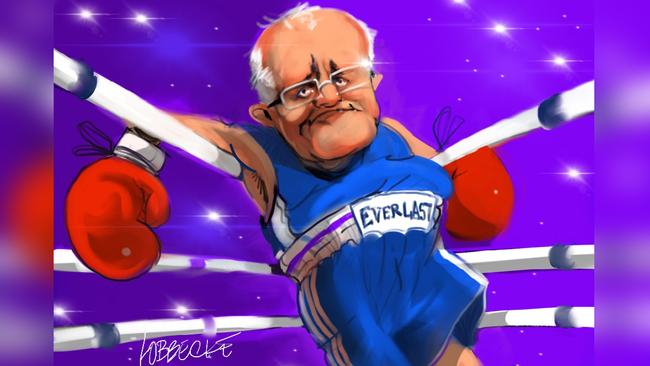PM’s pathway to victory passes through slippery terrain
Helloworld and Michaelia Cash aside, the government can take some rare cheer from recent events.

Despite problems managing the parliament alongside controversies such as Joe Hockey’s stake in Helloworld and Michaelia Cash’s weasel words in Senate estimates, the Coalition would be happy with the past sitting fortnight.
A wedge issue on border protection, exposing factional tensions and inconsistencies between shadow ministers, gave the government the scare campaign it wanted. A poll putting the government just two points behind Labor boosted morale among MPs, even if it was the often unreliable Ipsos survey. And plans to shift ground back on to Labor’s taxation policy agenda ahead of the budget, where Josh Frydenberg will forecast a surplus, give the government a narrative in a policy space it traditionally dominates.
While Labor had hoped to use the two-week sitting period to expose the institutional weaknesses of the Coalition, reminding the public of government inaction on the banks along the way, these issues — real as they were — didn’t dominate the agenda.
Nevertheless, Labor remains in the box seat to win the election. A Scott Morrison victory in May would be the biggest comeback in Australian political history. Bill Shorten would replace John Hewson as the opposition leader who lost the unlosable election.
But the betting agencies — traditionally more accurate than the polls — still have Labor as firm favourite. The simple fact is the election is probably too soon and the government’s minority status is too precarious for history to be written. Paul Keating was able to beat Hewson in 1993 only because he took over the Labor leadership from Bob Hawke in 1991, not a mere nine months out from polling day, as is the case for Morrison. And Keating went into the 1993 election with a majority he could defend, in the end increasing Labor’s vote.
Morrison only has 74 seats, fewer still when you consider electoral redistributions. He has to win seats from Labor to form majority government, all the while fighting independents in heartland seats, sapping party finances needed to fund marginal seat contests.
Throw in the inconsistencies from state to state — what works in Queensland and Western Australia won’t win votes for the Liberals in Victoria — and the degree of difficulty for Team Morrison to manufacture a victory is sky-high. But we can, for the first time, take seriously the strategy that the government would need to adopt to pull off the unthinkable: a third term in power.
It goes like this: starting with 74 seats, the Coalition hopes to mount a serious challenge for the Labor-held seat of Herbert in north Queensland, Bass in Tasmania and Lindsay in Sydney’s west. It also fancies its chances to regain Indi in regional Victoria following independent Cathy McGowan’s decision to retire, although local Liberals say the electorate is more likely to return another independent rather than return to the conservative fold. Wentworth is also in play, with Kerryn Phelps having won by the barest of margins. Liberals hope that her high-profile involvement in the medivac laws could harm her, but it’s unclear if voters will warm to the scare campaign on boats Morrison is mounting.
Bass is a target seat because Liberals consider the local Labor MP weak. Herbert in flood-affected north Queensland is one of the tightest seats in the country, and the theory is that Malcolm Turnbull wasn’t popular that far north. Lindsay has long been a bellwether seat of sorts, but it is the border protection debate that Liberals believe just might swing the seat back their way.
If all of the above goes the way of the government — and of course that’s unlikely — it would lift its seats total to 79. But that is before we consider which seats it looks set to lose. While Liberals might hope they can use border protection politicking to hold the line in Queensland and WA, that’s probably wishful thinking. Peter Dutton’s seat of Dickson, for example, is being targeted by GetUp. Petrie will be a tough hold, given the role Luke Howarth played in knifing Turnbull, and several seats in WA are marginal.
But it’s the southern state of Victoria that really adds to Morrison’s degree of difficulty. We saw in the state election that Victorians don’t appreciate Liberal scare campaigns. Dumping Turnbull has put Dunkley, Corangamite, La Trobe, Deakin, Aston and even Flinders on Labor’s radar, remembering that Shorten is himself a Victorian. Chisholm appears unwinnable now Julia Banks has deserted the Liberals to challenge Greg Hunt as an independent. Hunt not only backstabbed Turnbull but he did so in sharp contrast to the attitudes of his urbane Victorian electorate.
Then we have the reality of retirements, and the difficulty of holding seats known as swing seats when popular locals depart. Ann Sudmalis is retiring in the very marginal seat of Gilmore, having cited male bullying within the party as her reason for going. Morrison instituted a judgment-lacking captain’s call to parachute former Labor Party president Warren Mundine in as the Liberal candidate. Mundine isn’t even from the area. In WA, Michael Keenan was a popular local campaigner, frequently holding Stirling against so-called star Labor candidates. His retirement exposes the 6.1 per cent seat to a Labor tilt. And Reid in NSW will almost certainly see Turnbull ally Craig Laundy walk away from politics, giving the traditional Labor seat back to Labor in the process.
To pull off the greatest political comeback of all time, Morrison needs to find a way to minimise all of the above, and he will have to do it with less money than Labor, fewer third-party endorsements and a less sophisticated campaign machine. While Morrison is a strong campaigner, so is Shorten, as he proved in 2016. Throw in the woes of the Nationals, and the challenge only becomes greater.
John Howard orchestrated political comebacks in 1998, 2001 and 2004, but on each occasion he had sizeable advantages Morrison simply lacks, starting with a more powerful campaign unit than the Liberals have now. In 1998, Howard used his sizeable majority from 1996 to eke out a narrow win. In 2001 he used a real border protection issue, not a confected one like Morrison is trying to misrepresent today. And in 2004 Howard had the greatest gift a PM on the ropes could hope for — Mark Latham as opposition leader.
Morrison’s pathway to victory is unquestionably more difficult. But the past fortnight has at least given conservatives some hope.
Peter van Onselen is a professor of politics at the University of Western Australia and Griffith University.



